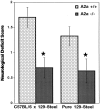A(2A) adenosine receptor deficiency attenuates brain injury induced by transient focal ischemia in mice
- PMID: 10531422
- PMCID: PMC6782932
- DOI: 10.1523/JNEUROSCI.19-21-09192.1999
A(2A) adenosine receptor deficiency attenuates brain injury induced by transient focal ischemia in mice
Abstract
Extracellular adenosine critically modulates ischemic brain injury, at least in part through activation of the A(1) adenosine receptor. However, the role played by the A(2A) receptor has been obscured by intrinsic limitations of A(2A) adenosinergic agents. To overcome these pharmacological limitations, we explored the consequences of deleting the A(2A) adenosine receptor on brain damage after transient focal ischemia. Cerebral morphology, as well as vascular and physiological measures (before, during, and after ischemia) did not differ between A(2A) receptor knock-out and wild-type littermates. The volume of cerebral infarction, as well as the associated neurological deficit induced by transient filament occlusion of the middle cerebral artery, were significantly attenuated in A(2A) receptor knock-out mice. This neuroprotective phenotype of A(2A) receptor-deficient mice was observed in different genetic backgrounds, confirming A(2A) receptor disruption as its cause. Together with complimentary pharmacological studies, these data suggest that A(2A) receptors play a prominent role in the development of ischemic injury within brain and demonstrate the potential for anatomical and functional neuroprotection against stroke by A(2A) receptor antagonists.
Figures




References
-
- Banbury conference on genetic background in mice. Mutant mice and neuroscience: recommendations concerning genetic background. Neuron. 1997;19:755–759. - PubMed
-
- Bona E, Aden U, Gilland E, Fredholm BB, Hagberg H. Neonatal cerebral hypoxia ischemia: the effect of adenosine receptor antagonists. Neuropharmacology. 1997;36:1327–1338. - PubMed
-
- Bonventre JV, Huang Z, Taheri MR, O'Leary E, Li E, Moskowitz MA, Sapirstein A. Reduced fertility and postischemic brain injury in mice deficient in cytosolic phospholipase A2. Nature. 1997;390:622–625. - PubMed
-
- Chen J-F, Fink JS. Characterization of the genomic structure of mouse A2aR adenosine receptor gene. Soc Neurosci Abstr. 1996;22:1569.
Publication types
MeSH terms
Substances
Grants and funding
LinkOut - more resources
Full Text Sources
Other Literature Sources
Medical
Molecular Biology Databases
